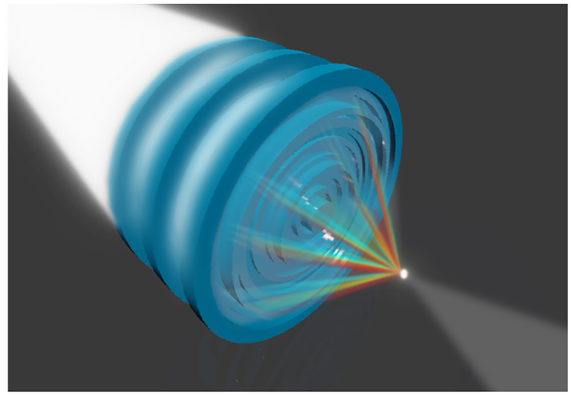Researchers in Singapore and China have proposed a new approach to designing high-numerical-aperture, broadband, and polarization-insensitive multilayer achromatic metalenses using 3D printing and topology optimization. The team, led by Cheng-Feng Pan, combined topology optimization and full wavelength simulations to design the metalenses, which were fabricated using two-photon lithography. The researchers demonstrated the broadband imaging performance of the metalenses under white light and narrowband illuminations. The results, published in Science Advances, highlight the potential of 3D-printed multilayer structures to realize broadband and multifunctional meta devices.
Metalenses are ultra-compact, ultra-thin, and lightweight, making them ideal for a variety of applications in fields such as light-field imaging, bioanalysis, medicine, and quantum technologies. However, most metalenses are patterned using high-refractive-index materials, making broadband implementation challenging. To address this challenge, the researchers used 3D printing, specifically nanoscale 3D printing using two-photon polymerization, to pattern the multilayer lenses in a single lithographic step.
The team employed topology optimization to achieve achromatic lensing behavior, resulting in stable, multilayer, and high-resolution structures. The fabricated multilayer achromatic metalenses exhibited exceptional performance, integrating the advantages of nanoscale high-resolution 3D printing. These metalenses offer a new paradigm for the design and fabrication of multifunctional broadband optical elements and devices.
One key difference between multilayer metalenses and multilayer diffractive lenses is the size of the smallest feature. The researchers turned the designed structures into real constructs using filtering and binarization steps. The fabrication method was optimized using a 3D printing system that utilizes a galvo-scanned focused beam to induce crosslinking of a liquid resin into a nanoscale solid voxel at the focal spot.
The engineered metalenses performed well under white light, exhibiting high focusing efficiency and removing chromatic aberrations. The researchers optimized the parameters to achieve the designed metalenses with nanoscale features precisely. The stacked metasurfaces, which are based on low-refractive-index materials, overcame the limits of single-layer flat optics, extending the performance of the metalenses into broadband functions while preserving the high numerical aperture.
Looking ahead, the use of higher-resolution 3D printing methods and high-refractive-index resins could enable the development of multifunctional optical systems that operate with a broadband response range beyond the visible range, extending into the near or mid-infrared range. This research has significant implications for the advancement of optical technologies and could pave the way for innovative applications in various fields.

